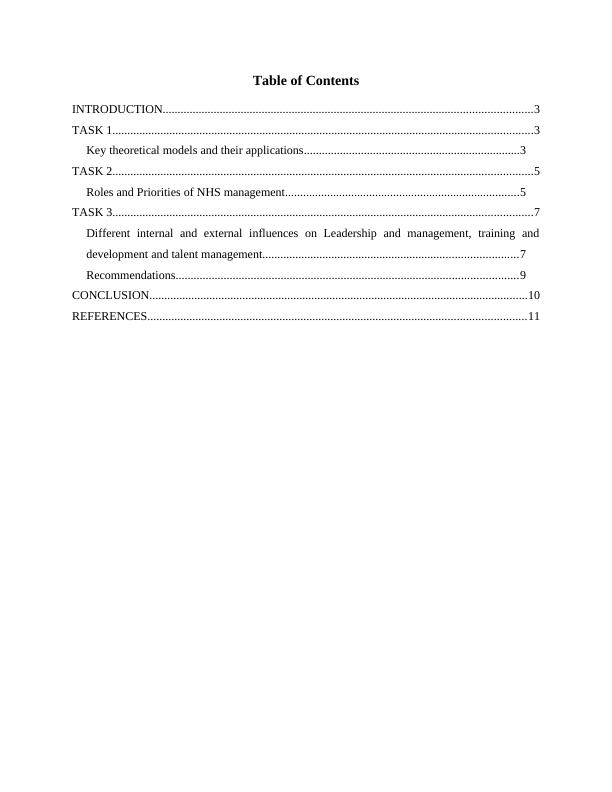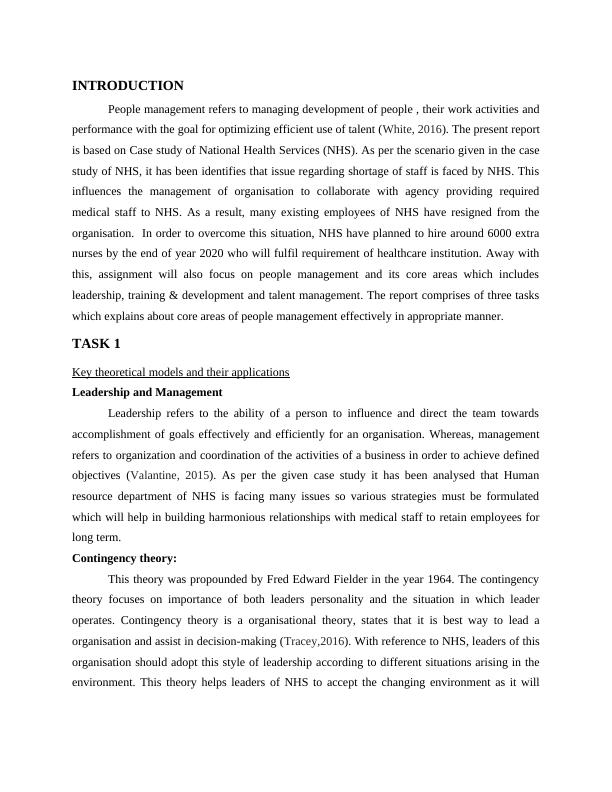Introduction to People Management (pdf)
11 Pages2825 Words409 Views
Added on 2020-12-10
Introduction to People Management (pdf)
Added on 2020-12-10
ShareRelated Documents
Introduction toPeopleManagement

Table of ContentsINTRODUCTION...........................................................................................................................3TASK 1............................................................................................................................................3Key theoretical models and their applications........................................................................3TASK 2............................................................................................................................................5Roles and Priorities of NHS management..............................................................................5TASK 3............................................................................................................................................7Different internal and external influences on Leadership and management, training anddevelopment and talent management.....................................................................................7Recommendations..................................................................................................................9CONCLUSION..............................................................................................................................10REFERENCES..............................................................................................................................11

INTRODUCTIONPeople management refers to managing development of people , their work activities andperformance with the goal for optimizing efficient use of talent (White, 2016). The present reportis based on Case study of National Health Services (NHS). As per the scenario given in the casestudy of NHS, it has been identifies that issue regarding shortage of staff is faced by NHS. Thisinfluences the management of organisation to collaborate with agency providing requiredmedical staff to NHS. As a result, many existing employees of NHS have resigned from theorganisation. In order to overcome this situation, NHS have planned to hire around 6000 extranurses by the end of year 2020 who will fulfil requirement of healthcare institution. Away withthis, assignment will also focus on people management and its core areas which includesleadership, training & development and talent management. The report comprises of three taskswhich explains about core areas of people management effectively in appropriate manner.TASK 1Key theoretical models and their applicationsLeadership and ManagementLeadership refers to the ability of a person to influence and direct the team towardsaccomplishment of goals effectively and efficiently for an organisation. Whereas, managementrefers to organization and coordination of the activities of a business in order to achieve definedobjectives (Valantine, 2015). As per the given case study it has been analysed that Humanresource department of NHS is facing many issues so various strategies must be formulatedwhich will help in building harmonious relationships with medical staff to retain employees forlong term. Contingency theory: This theory was propounded by Fred Edward Fielder in the year 1964. The contingencytheory focuses on importance of both leaders personality and the situation in which leaderoperates. Contingency theory is a organisational theory, states that it is best way to lead aorganisation and assist in decision-making (Tracey,2016). With reference to NHS, leaders of thisorganisation should adopt this style of leadership according to different situations arising in theenvironment. This theory helps leaders of NHS to accept the changing environment as it will

further help in employee retention for long period. Along with this contingency theory will alsoassist management of NHS in effective decision-making in future. Training and development Training is the process of learning the skills required to perform a particular activity orjob whereas, development is the framework which is used to help employees develop theirpersonal and organisational skills (Shanks,2016).Instructional System Development Model:This model was formulated to answer to the training problems and it is mostly used inevery organisation as it is concerned with training need on the job performance. In the context ofNHS, this model will help the organisation in identification of training problems and finding outsolution in cost effective manner. This model will also help leaders to solve the problem ofemployee turnover.Talent Management Talent management is very useful term as it refers to anticipation of required humancapital for an organisation and planning to meet these needs (Robson,2016).Expectancy theory: This theory was propound by Victor Vroom. According to thistheory, a company should manage its employees by motivating them (Noe,2017). In context ofNHS, managers needs to ensure that their staff has desire to develop and accept the change. Also,employees turnover can be reduced by motivating them by rewards and incentives.For example, leaders of NHS uses contingency leadership style, so that they are able toadopt different leadership styles in different situations. Due to all this, manager of NHS is able toprovide proper training and development sessions to their employees, and also capable to hirenew candidates, which are required by them.

End of preview
Want to access all the pages? Upload your documents or become a member.
Related Documents
People Management Assignment - Case Study of NHSlg...
|12
|2710
|418
Introduction to People Managementlg...
|11
|2437
|97
Introduction to People Managementlg...
|10
|2642
|94
A Study On Portfolio Managementlg...
|9
|2747
|429
People Management in NHS Case Studylg...
|10
|2671
|39
Introduction to People Management- Assignmentlg...
|11
|2655
|308
